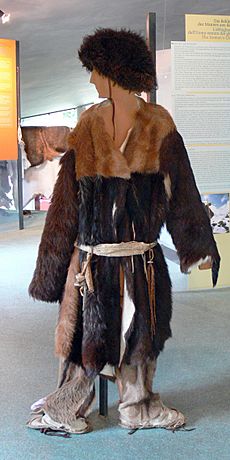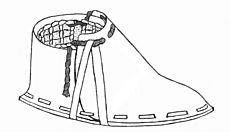Ötzi facts for kids
Quick facts for kids
Ötzi
|
|
|---|---|
| Pronunciation | German pronunciation: [ˈœtsi] |
| Born | c. 3275 BC |
| Died | c. 3230 BC (aged about 45) Ötztal Alps, near Tisenjoch on the border between Austria and Italy
|
| Other names | Ötzi the Iceman Similaun Man (Italian: Mummia del Similaun) Man from Tisenjoch Man from Hauslabjoch Frozen Man Frozen Fritz Tyrolean Iceman |
| Known for | Oldest natural mummy of a Chalcolithic (Copper Age) European man |
| Height | 1.6 m (5 ft 3 in) |
Ötzi, also known as the Iceman, is the naturally preserved body (a natural mummy) of a man who lived a very long time ago, between 3350 and 3105 BC. That's over 5,000 years ago!
Ötzi was found in September 1991 in the Ötztal Alps, which is where he got his nickname. This area is right on the border between Austria and Italy. He is the oldest known natural human mummy in Europe. He gives us an amazing look into the lives of people during the Chalcolithic (Copper Age).
Scientists believe Ötzi was murdered. How he lived and what happened when he died are still big mysteries. You can see his body and all his belongings at the South Tyrol Museum of Archaeology in Bolzano, South Tyrol, Italy.
Contents
How Ötzi Was Found
Ötzi was discovered on September 19, 1991, by two German hikers, Helmut and Erika Simon. They were high up in the Ötztal Alps, about 3,210 meters (10,530 feet) above sea level. At first, they thought they had found a recently deceased mountaineer.
Many people visited the site after the discovery, including famous mountaineers Hans Kammerlander and Reinhold Messner. Ötzi's body was carefully removed on September 22 and taken to a medical office in Innsbruck.
An archaeologist named Konrad Spindler examined the body and items found with it. He quickly realized Ötzi was very old, at least 4,000 years. Later tests on Ötzi's body and belongings showed he lived between 3359 and 3105 BCE. This means he was indeed about 5,000 years old!
Where Was He Found?
After Ötzi was found, there was a small debate about which country he was in. The border between Austria and Italy in that area was set in 1919. Even though the water from the site flowed towards Austria, later surveys showed Ötzi was actually found about 92.56 meters (101.22 yards) inside Italian territory.
Because of this, the province of South Tyrol (in Italy) claimed ownership of Ötzi. They agreed to let the University of Innsbruck finish its studies. Since 1998, Ötzi has been on display in the South Tyrol Museum of Archaeology in Bolzano, Italy.
Scientific Discoveries About Ötzi
Scientists have studied Ötzi's body and belongings very closely. They have measured him, taken X-rays, and examined his tissues and stomach contents. This research helps us learn a lot about life in the Copper Age.
Ötzi's Body and Appearance
When Ötzi died, he was about 160 cm (5 ft 3 in) tall and weighed around 50 kg (110 lb). He was about 45 years old. When his body was found, it weighed 13.75 kg (30 lb 5 oz) because it was so well preserved.
Scientists studied pollen, dust, and his tooth enamel. This showed that Ötzi grew up near a village called Feldthurns in South Tyrol. Later, he moved to valleys about 50 km (31 miles) north.
Tests on Ötzi's hair showed high levels of copper and arsenic. This, along with his copper axe blade (which was 99.7% pure copper), suggests he might have been involved in smelting copper. This means he helped make copper tools.
By looking at his leg and hip bones, scientists think Ötzi walked a lot over hilly land. This was not common for other people in Europe during the Copper Age. It might mean Ötzi was a shepherd who took his animals to high mountains.
Using modern 3D scanning technology, scientists made a reconstruction of Ötzi's face. It shows him looking older than 45, with deep-set brown eyes, a beard, and a tired, rugged face.
Ötzi's Health
Ötzi had a type of intestinal parasite called whipworm. CT scans showed that some of his ribs were cracked after he died, likely from the ice pressing on his body.
One of his fingernails showed three lines, which means he was sick three times in the six months before he died. The last sickness, two months before he died, lasted about two weeks. His outer skin layer was missing, which is normal for a body preserved in ice.
Ötzi's teeth had many cavities. This might have been caused by his diet, which included a lot of grains and carbohydrates. DNA tests also showed that Ötzi was lactose intolerant. This suggests that many people in his time still had trouble digesting milk, even as farming and dairy became more common.
Tattoos on Ötzi's Body
Ötzi had 61 tattoos! They were groups of black lines, between 1 and 3 mm thick and 7 to 40 mm long. These tattoos included parallel lines along his back, a cross shape behind his right knee and on his right ankle, and lines around his left wrist. Most of the tattoos were on his legs.
Scientists found that the tattoos were made from fireplace ash or soot. This pigment was rubbed into small cuts or punctures in his skin. Many tattoos were very dark, suggesting he might have been tattooed in the same spots more than once.
X-rays of Ötzi's bones showed signs of wear and tear, especially in his lower back, knees, and ankles. Many of his tattoos were located near these worn-out areas. This has led some scientists to believe the tattoos might have been a form of pain relief, similar to acupressure or acupuncture. If this is true, it means these types of treatments were used much earlier than previously thought. For example, the tattoos on his chest are on spots that are thought to help with stomach pain. Since Ötzi had whipworm, which causes stomach pain, these tattoos could have helped him feel better.
Many of Ötzi's tattoos were hard to see with the naked eye. In 2015, researchers used special cameras that could see different light wavelengths. This helped them find all of his tattoos.
Ötzi's Clothes and Shoes
Ötzi wore clothes made from different animal skins and woven grass. He had a grass cloak, a coat, a belt, leggings, a loincloth, and shoes. His hat was made of bearskin with a leather chin strap.
His shoes were waterproof and wide, perfect for walking in snow. They had soles made of bearskin, tops made of deer hide, and a netting made of tree bark. Soft grass was put inside the shoes, like modern socks, to keep his feet warm.
His coat, belt, leggings, and loincloth were made from strips of leather sewn together with animal sinew. His belt had a small pouch with useful items like a scraper, a drill, a flint flake, a bone awl, and a dried fungus.
Scientists have even recreated Ötzi's shoes. They found the shoes were quite complex, suggesting that people 5,300 years ago might have had special shoemakers.
Genetic tests on his clothing showed that his loincloth and coat were made from sheepskin, similar to modern domestic sheep. Part of his coat was also made from domesticated goat. His leggings were made from goat leather. His shoelaces were made from cattle, and his fur hat was made from a brown bear.
Ötzi's Tools and Equipment
Ötzi carried many important tools. He had a copper axe with a yew wood handle. He also had a chert-bladed knife with an ash wood handle.
He carried a quiver with 14 arrows. Two of the arrows were broken and had flint tips and fletching (feathers to help them fly straight). The other 12 arrows were unfinished. The quiver also held a bow string, an unknown tool, and an antler tool for sharpening arrow points. He also had an unfinished longbow made of yew wood, which was 1.82 meters (6 feet) long.
Among his belongings were also some berries, two birch bark baskets, and two types of polypore mushrooms. One mushroom, the birch fungus, is known to have properties that fight worms, so it was likely used as medicine. The other mushroom was a type of tinder fungus, which was part of a complex firelighting kit. This kit included pieces of many different plants, along with flint and pyrite for making sparks.
Ötzi's copper axe was very special. Its handle was 60 cm (24 in) long and made from yew wood. The axe head was 9.5 cm (3.7 in) long and made of almost pure copper. Studies show the copper came from southern Tuscany, not the Alps. The axe head was attached to the handle with birch-tar and strong leather straps. The axe showed clear signs of being used for chopping. In Ötzi's time, such an axe would have been very valuable and a sign of high status.
Ötzi's Blood
In 2012, scientists made an amazing discovery: Ötzi still had intact blood cells! These are the oldest complete human blood cells ever found. In most ancient bodies, blood cells are shrunken or gone. But Ötzi's blood cells were the same size as living red blood cells and looked like a modern sample.
What Caused Ötzi's Death?
For a long time, no one knew exactly how Ötzi died. At first, people thought he might have died from being exposed to a winter storm. Some even thought he might have been a ritual sacrifice.
However, about 10 years after his discovery, scientists found an arrowhead in his left shoulder. This strongly suggests that Ötzi was murdered. He likely bled to death from the injury.
Legal Dispute Over Ötzi
Italian law says that people who find valuable items can get a reward. The Simons, who found Ötzi, were offered a small reward, but they thought it wasn't enough.
In 2003, the Simons went to court to be officially recognized as the discoverers. The court agreed with them. They then asked for a larger fee. The government of South Tyrol disagreed with the amount.
Sadly, Helmut Simon died in 2004. In 2006, an appeals court confirmed that the Simons were indeed the discoverers and should get a fee. Mrs. Erika Simon then asked for €150,000. The government argued that they had spent a lot of money on the museum and preserving Ötzi.
Finally, in 2008, the government and Mrs. Simon reached an agreement. She received €150,000 to recognize her and her late husband's discovery of Ötzi.
See also
 In Spanish: Ötzi para niños
In Spanish: Ötzi para niños
- Iceman – a 2017 movie about Ötzi's life
- List of unsolved murders
- Similar archaeological finds:
- Children of Llullaillaco and Mummy Juanita – ancient mummies found high in the Andes mountains
- Gebelein predynastic mummies – Egyptian mummies from around the same time as Ötzi
- Saltmen – well-preserved mummies found in salt mines in Iran
- Tarim Basin Mummies – well-preserved mummies from Central Asia







